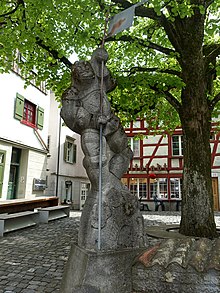Werner Hilber
Werner Hilber (born August 28, 1900 or August 30, 1900 in Wil , Canton St. Gallen , † November 5, 1989 in Kronbühl- Wittenbach , Canton St. Gallen or November 6, 1989 in Zurich ) was a Swiss sculptor and painter .
life and work
Werner Hilber's parents ran a small shop for linen and fabrics in the “Pelikan” house at Markgasse 10 in Wil. Together with five siblings, Werner Hilber grew up in a musical environment. Playing his own improvised melodies on the piano or drawing and painting, his talents expressed themselves at an early age. His older brother was the later composer and church musician Johann Babtist Hilber (1891–1973).
After finishing school, he trained as a wood sculptor at the Wiler Altarbauer Gebrüder Marmon & Blank . Hilber had a lung disease until 1965, which repeatedly forced him to stay at a spa. So his father supported him and enabled him to continue his artistic training. From 1921 to 1922 he attended the arts and crafts school in Zurich . In 1925 he attended the sculpture class at the Academy of Fine Arts in Munich for a summer semester . Hilber was a student of Joseph Wackerle .
From 1927 to 1930 Hilber stayed in Paris at the Académie de la Grande Chaumière . His teacher was Antoine Bourdelle . During these years he produced many expressionist wood carvings as well as numerous nudes and portrait studies in various designs. In Paris he learned a. a know Alberto Giacometti , Otto Charles Bänninger and Jacques Lipchitz , with whom he remained lifelong friends.
Back in his hometown, he created numerous works for public spaces in Wil in the studio on Tonhallestrasse. For example the sculptures on the Bärenbrunnen and Böckebrunnen or in 1932 the relief of the priestly graves at St. Peter's Church, as well as various works in the St. Nicholas Church in 1933. In 1939 he was able to exhibit a relief made of artificial stone for the agriculture / crop production department at the Swiss National Exhibition.
From 1938 to 1940 Hilber lived and worked with his partner and muse Beatrix, known as “Trixli”, in Ticino and from 1940 to 1945 in Valais . Here, too, he painted numerous landscapes, partly in oil on canvas or as gouaches using various mixed techniques on hardboard. In the fifties Hilber dealt more and more with ceramics . This is how small ceramics were created that often have roosters or bulls as a motif. His uncompromising artistic and personal freedom was paramount to Hilber. In addition, he would have preferred not to sell his pictures, which often led to financial difficulties.
He moved into his second studio in 1945 at Neumarkt in Zurich. Many of his realistic, expressive and surrealist works were created there. A relief of the Kleine Fugue , called Frau Musica , adorns the over door of house No. 20 on Froschaugasse in Zurich. This was installed in 1964 on behalf of the City of Zurich. In 1965 Hilber was cured of his lung disease. A new creative period began for him, which continued in his new studio at Chorgasse 11 in Zurich.
Hilber was a freedom-loving, creative, philosophizing and independent artist all his life. He bequeathed a large part of his diverse work to the city of Wil. The works were inventoried and administered by the city. In 1994 the Werner Hilber Foundation was established, which in 2012 was merged with the Kunstmaler Karl Peterli Foundation and the Kunstmaler Karl Glauner Foundation to form the new Wiler Artists Foundation.
Selection of works
- 1932: Relief of the priestly graves at the Catholic Church of St. Peter, Wil SG
- 1933: various jobs in the Catholic Church of St. Nikolaus, Wil SG
- 1935: Bear fountain sculpture, bears with the drum , Wil SG
- 1939: Relief made of artificial stone for the Agriculture and Plant Production Department, Swiss National Exhibition ,
- 1951: Böckebrunnenskulptur, Wiler Böcke , Wil SG
- 1964: Sculpture Frau Musica , Zurich
Exhibitions
- 1936: National Art Exhibition, Kunstmuseum Bern
- 1936: Young Swiss Art, Lucerne Art Museum
- 2000: Werner Hilber memorial exhibition, Wil SG
- 2003: Labyrinth of Life, Rheinau ZH
Web links
- Hilber, Werner. In: Sikart
- Werner Hilber career and images in Wilnet
- Werner Hilber Wiler Artist Foundation
Individual evidence
- ↑ a b WilNet: Hilber family tree. In: wilnet.ch. City of Wil, accessed on May 21, 2019 : "Alois Werner Hilber / * 30. VIII 1900 / Sculptor / in Wil"
- ↑ Werner Hilber. In: wilerbuerger.ch. Local church Wil, accessed on October 2, 2019 .
- ↑ Werner Hilber. In: tagblatt.ch. CH Media, October 3, 2012, accessed on October 2, 2019 . ,
- ↑ WilNet: Johann Babtist Hilber. Retrieved May 21, 2019 .
- ^ Academy of Fine Arts Munich: Werner Hilber, 1925, register book. Retrieved June 12, 2019 .
- ↑ WilNet: Munich and Paris. Retrieved May 20, 2019 .
- ↑ WilNet: 1930-38. Retrieved May 20, 2019 .
- ↑ WilNet: Swiss National Exhibition, 1939. Retrieved on May 20, 2019 .
- ↑ WilNet: 1938-45. Retrieved May 20, 2019 .
- ↑ WilNet: 1945-65. Retrieved May 20, 2019 .
- ↑ WilNet: 1965-89. Retrieved May 20, 2019 .
- ↑ Wiler Artist Foundation. Retrieved May 22, 2019 .
| personal data | |
|---|---|
| SURNAME | Hilber, Werner |
| BRIEF DESCRIPTION | Swiss sculptor, painter, musician, philosopher and bon vivant |
| DATE OF BIRTH | August 30, 1900 |
| PLACE OF BIRTH | Wil SG |
| DATE OF DEATH | November 6, 1989 |
| Place of death | Zurich |


